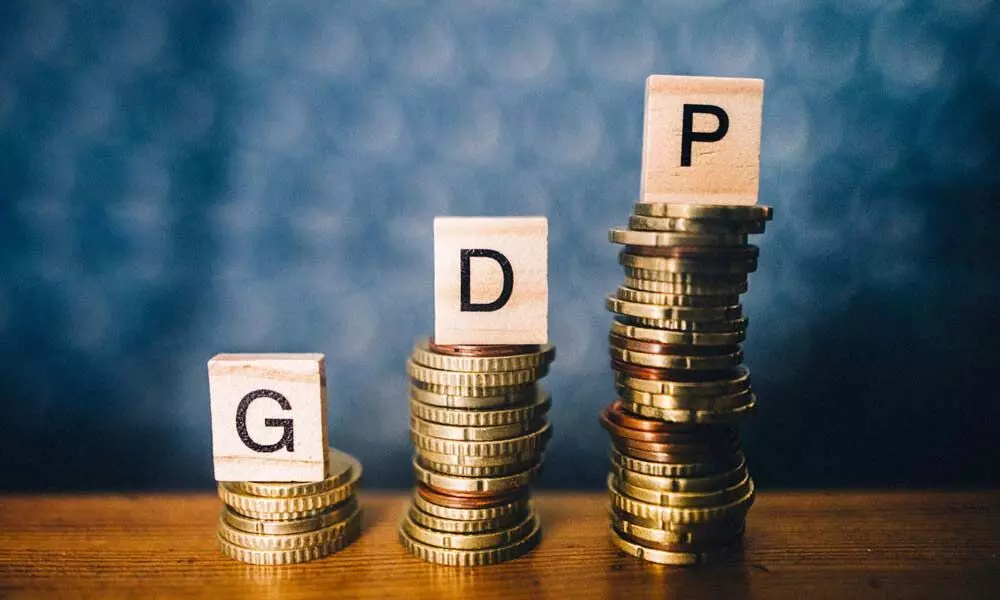FY22 real GDP estimates higher by Rs. 18,000 cr than Budget estimates
For the full fiscal GDP growth is expected to increase by 8.9% (SBI: 8.8%) and GVA growth by 8.3% as growth seems to have somewhat lost its momentum: SBI report
image for illustrative purpose

For FY23 nominal GDP growth comes to 9.1% from 11.1% (given in the budget). Assuming same growth rate of 11.1% on the new GDP numbers for FY22, fiscal deficit for FY23 will also come down to 6.3% of GDP from the budgeted 6.4% of GDP
Mumbai: The real GDP estimates for the current fiscal are higher by Rs18,000 crore than budget estimates. India's economy grew by 5.4 per cent in Q3 FY22 after exhibiting 8.5 per cent growth in Q2 and 0.7 per cent in same quarter last fiscal, bringing to the fore pain points inherent as we enter the third year of pandemic.
For the full fiscal GDP growth is expected to increase by 8.9 per cent (SBI: 8.8 per cent) and GVA growth by 8.3 per cent as growth seems to have somewhat lost its momentum. At 8.9 per cent, Q4 GDP growth is printing at 4.8 per cent.
Given the impact (though not so serious) of Omicron variant and Russia-Ukraine crisis in Q4, we believe that Q4 GDP growth would be lower than 4.8 per cent pushing down GDP FY22 real GDP growth below 8.9 per cent with downward bias around lower end of spectrum of consensus estimates hovering around 8-10 per cent, says an internal economic research report by SBI.
The 'trade, hotels, transport, communication and services related to broadcasting' are the only sectors which are still not out of woods. The Q3 absolute numbers of these sectors are still 95 per cent lower than the pre-pandemic level (Q3 FY20). However, if we compare on cumulative basis (Apr-Dec'21 over Apr-Dec'19), the 'trade, hotels, transport, communication and services related to broadcasting' is still 84 per cent of its pre-pandemic level and construction is still 97 per cent of pre-pandemic level, it said.
On a positive note, during 2021-22, signs of recovery became visible in H1 with credit growth on incremental basis increasing by Rs 5.9 lakh crore (5.4 per cent), compared to last year growth of Rs 3.32 lakh crore (3.2 per cent) with personal loans, agriculture sector and industry being the drivers of growth. Deceleration in credit growth in the services sector continued though credit to industry showed signs of improvement. However, ASCBs deposits growth is lagging and grew by 9.1 per cent for the fortnight ended February 11 compared to last year growth of 11.8 per cent. RBI's latest quarterly statistics indicate muted growth in sequential deposits (Q-o-Q) in the third quarter across demographics which inter-alia vindicates our earlier hypothesis of asymmetrical growth in deposit accretion across various geo-population groups with incremental share in SB and CA facilities vis-à-vis time deposits showing general depositor's shift to 'on demand' mode, to counter the direct fallouts as well as ripple effects.
"On the capital formation side, the pickup is inching towards pre-pandemic level but the trend in change in stocks show sharp accumulation indicating the demand is weaning. Sharpe rise in share of valuables also indicate postponement of current consumption and leakage of financial savings towards precious metals," says Soumya Kanti Ghosh, SBI group's chief economic advisor.
All the heads under the expenditure side have advanced but still remain below the pre-pandemic level in December. Private consumption is below the pre-pandemic level and this is largely because labour intensive sector trading and construction have not recovered from the pandemic shock. The recovery in these sectors remains patchy. Sharpe rise in share of valuables also indicate postponement of current consumption and leakage of financial savings towards precious metals, he said.
With FY22 nominal GDP now at Rs 2.36 lakh crore compared to the first advanced estimate of Rs 2.32 lakh crore based on which the deficit numbers in the budget were given, fiscal deficit as percentage of GDP will now be revised down to 6.7 per cent from 6.9 per cent of GDP in the budget. For FY23 nominal GDP growth comes to 9.1 per cent from 11.1 per cent (given in the budget). Assuming same growth rate of 11.1 per cent on the new GDP numbers for FY22, fiscal deficit for FY23 will also come down to 6.3 per cent of GDP from the budgeted 6.4 per cent of GDP. Clearly, higher nominal GDP is eating away Government debt, though the dangers of higher inflation are many.
The ongoing conflict between Russia and Ukraine may impact certain high-frequency indicators (like financial markets, exchange rate and crude prices) in the short-term, we believe that at this moment this will not have any lasting impact on the Indian economy.
Core GVA has slowed down to 3 per cent in Q3 from 7.3 per cent in Q2. Core GVA and PFCE ideally follow the same trend. It thus remains to be seen how does PFCE picks up in FY23, as it will provide the fulcrum of an impending and nascent recovery. As of now, we are not revising our forecast for FY23 at 8 per cent, though any further event outlier and/or prolonging of the Ukraine-Russia conflict could act as a clear downside to our growth forecast.

